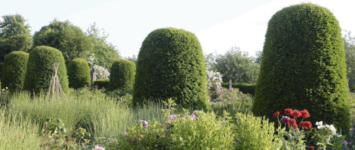
‘A garden should be the cosiest of places, but with some element of awe, menace, and glimpses of the wider landscape’
Isabel Bannerman shares her thoughts on making a garden that makes people feel at home.
September brings a strange surge of energy, gleaming cosmos and dahlias and all those rusty, dry, hairy plants: echinacea, rudbeckia, zinnias. Although we think of hedging and topiary as a winter benefit, during this year of almost continual deluge I realise they have come to count for more: their sharp-clipped, shadow-bearing forms have come into focus, throwing shapes early, noon and night.
Having relished the flossy shag of the yew’s greenest new growth in June, I dread the grand tidy up that comes with July; yet, when it is done, we smile with satisfaction at the rewarding new look. A firmer garden emerges, bronze Henry Moore curves, bold when the border plants are getting flopsome. September is rich in moonlight, when hedges and clipped forms come almost to life, moving and murmuring. Our regiment of topiary domes are individuals already, leaning and listening, sentries and scouts.
A garden should be the cosiest of places, but ideally also with some element of awe, menace even, glimpses of the wider landscape, sculptural height. A key lesson in landscape design is an understanding of how it could feel to move through a space once it has matured; looking up, as well as down, feeling the cool of a shadow followed by warmth from the sun. Our garden has little in the way of borrowed views, few trees of distinction, but, luckily, the church is a presence, as is the house itself. We realised the problem and the solution before we even bought the place and we ring-fenced a budget for buying yew trees, rather than kitchen units.
Taxus baccata is so universal, so extraordinarily adaptable and timeless, it can form the backbone of any style of garden, clipped into a peacock or a cottage fox, in a Jacques Wirtz masterpiece or a site as old as Audley End in Essex. Yew (with Scots pine and juniper) is a native conifer, integral in ancient mythology, closely retaining its Celtic name, ‘iwi’. Julius Caesar recounts how a king of the Eburones, the name of which tribe derived from yew, committed suicide by means of toxic yew brew. The plant as a place name crops up across Europe, from Evora in Portugal to Eburakon in Britain, now York.
“Topiary and hedges provide condominiums for birds, goldfinches particularly”
Animals will not dig under yew trees, knowing about their poison, so they were a good place for burials. Which came first — the body or the tree — we will never know, but yews abound in churchyards and many were built on previously pagan hallowed spots. A yew spear found at Clacton-on-Sea in Essex is the earliest-known manmade wood artefact, an unimaginable 450,000 years old. At Fortingall in Scotland, Llangernyw in North Wales and Runnymede in Surrey, there are yews well over 1,000 years old. John Evelyn in Silva (1662) loves yew for its ‘perennial verdure and durableness’ being ‘worth our patience’ for ‘standards, knobs, walks… hedges pyramids, conic spires’.
Taking our cue at this house, which fits with the first recorded usage of the word ‘topiary’ in 1592, we chose Taxus baccata and Lavandula angustifolia as the backbone of the garden design. Shadows play roundly on beehive domes or blobs of yew. Sharp pyramids and cubes, dark and brightly faceted, are also dramatic, giant sundials. The hedges here are cut, some square and some rounded in curvy waves to give us stage-set hills and valleys. I often wonder what people like so much about this garden, for the blackspot and weeds prevail, but I think this buxom enclosure, playful staginess, brings some deep familiarity to the place so newly made.
Practicality advises that, when planting yews, you put a foot-deep timber or plastic membrane around to contain the greedy roots outside your flower border. It can help to plant them proudish of the soil level — their hatred of wet feet stems from their origins on chalk and downland. Topiary and hedges provide condominiums for birds, goldfinches particularly. They dance with midges and hoverflies at evening, hedgehogs and dratted rabbits live deep in their bowls. Here, the old Irish yew is our only big tree, the best kind for cloaking in rambling roses or flame nasturtiums. This month, fieldfares will flock to hang upside down on it, gobbling the plush berries, the hard toxic centres of which pass right through the birds to be deposited elsewhere and grow into a new grove.
Isabel Bannerman is, with her husband, Julian, a leading garden designer and the author of ‘A Wilderness of Sweets: Making Gardens with Scented Plants’, to be published by Pimpernel Press in May 2025



